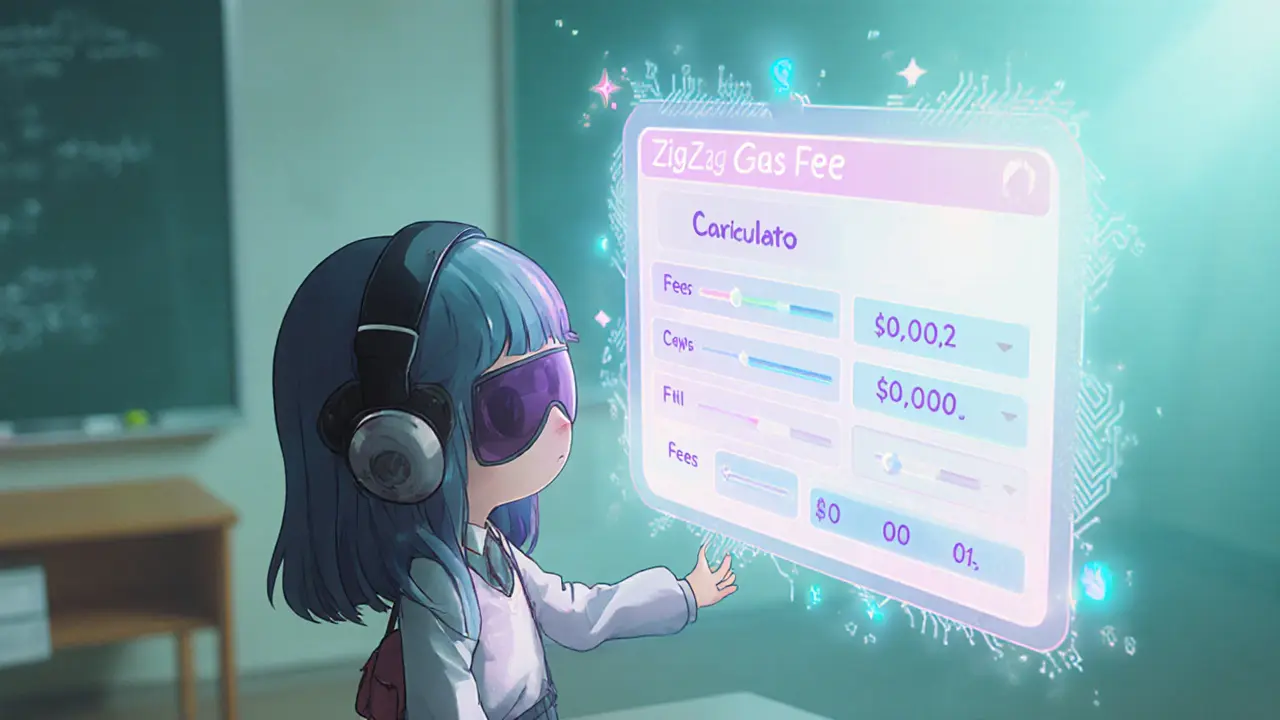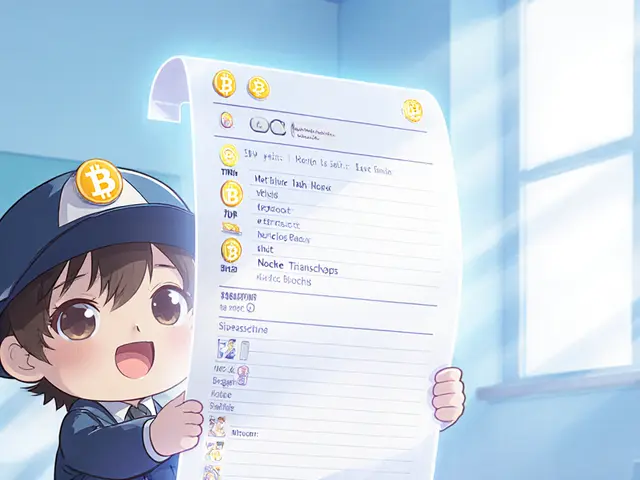ZigZag Gas Fee Calculator
ZigZag Exchange runs on zkSync Lite, offering near-zero gas fees for trades. Estimate how much you'd pay for different transaction types below.
Estimated Gas Fee
This estimate reflects typical zkSync Lite gas fees for ZigZag transactions. Actual fees may vary slightly depending on network congestion.
When you hear the term “decentralized exchange” most people picture automated‑market‑maker (AMM) platforms like Uniswap. ZigZag Exchange is a non‑custodial, order‑book DEX built on zkSync Lite that flips that script. Launched in November2021, ZigZag lets you trade spot tokens instantly, with gas fees that are practically zero thanks to ZK‑Rollup technology. If you’re curious whether it lives up to its hype, this review breaks down the tech, the user experience, tokenomics, and the risks you should know before opening a trade.
Quick Takeaways
- ZigZag runs on zkSync Lite, a ZK‑Rollup that offers sub‑cent gas fees and near‑instant finality.
- It uses a traditional order‑book model, delivering price quotes that often beat AMM slippage.
- The native governance token $ZZ shares fee revenue and lets holders vote on upgrades.
- MEV risk exists because a single operator batches trades, but a built‑in “force exit” protects funds from censorship.
- Future upgrades to zkSync Era will add full smart‑contract support and cross‑chain bridges.
How ZigZag Works on zkSync Lite
zkSync Lite is a ZK‑Rollup that bundles thousands of transactions off‑chain, then posts a compact zero‑knowledge proof to Ethereum. This proof guarantees that every state transition is valid without revealing the details. For ZigZag, that means each trade, deposit, or withdrawal is confirmed in seconds and costs a fraction of a cent in gas.
The exchange operates as an application‑specific platform within the zkSync Lite ecosystem. Because zkSync Lite does not support arbitrary smart contracts, ZigZag’s code runs as a pre‑approved module that reads and writes the public state directly. All order data-price, size, timestamps-is stored on‑chain as plain calldata, giving anyone the ability to audit trades long after they settle.
When you place an order, the operator aggregates it with dozens of others, generates a zk‑proof, and posts the new state to Ethereum. Once the block is final, the trade is considered settled. This process delivers the kind of speed you expect from a centralized exchange while keeping custody fully in the user’s wallet.
Order‑Book vs. AMM: What’s the Difference?
Most DeFi traders are familiar with AMM pools that set prices algorithmically. ZigZag’s order‑book model, by contrast, matches buyers and sellers directly, just like a traditional exchange. The result is tighter spreads and less slippage for large orders. Below is a side‑by‑side look at the two approaches.
| Feature | ZigZag (Order‑Book) | AMM (Uniswap) |
|---|---|---|
| Pricing Model | Live order matching, market‑driven quotes | Constant‑product formula (x·y=k) |
| Typical Fee | 0.20% taker, 0% maker | 0.30% on each swap |
| Gas Cost (zkSync Lite) | ~$0.001 per trade | ~$0.001 per swap (same rollup) |
| Settlement Time | Seconds (on‑chain finality) | Seconds (same rollup) |
| Custody | Non‑custodial, wallet‑to‑wallet | Non‑custodial, wallet‑to‑wallet |
| MEV Exposure | Operator can front‑run; mitigated by force‑exit | Minimal (price is set by pool) |
| Liquidity Source | Order flow from market makers | Liquidity providers’ pool reserves |
For traders who move large amounts or need precise price discovery, the order‑book format is a clear advantage. Small retail swaps, however, may find AMMs simpler because they don’t need to wait for a matching counter‑party.
Tokenomics: The Role of $ZZ
The native token, $ZZ, serves two purposes. First, it powers the decentralized autonomous organization (DAO) that decides on fee structures, future feature rollouts, and bridge integrations. Second, holders receive a share of the platform’s revenue-fees collected on zkSync Lite are redistributed proportionally.
Key numbers:
- Total supply: 100million $ZZ
- Community allocation: 60.7% (covers DAO, incentives, liquidity)
- Current price (Oct2025): roughly $0.0015
- Tradeable on ZigZag and on Ethereum’s Uniswap v3
ZigZag has already executed three airdrop rounds, automatically crediting $ZZ to any zkSync Lite address that meets activity thresholds. Users can verify their balances on zkScan or through third‑party dashboards like Trustalabs.ai.
Security, Censorship‑Resistance, and MEV Risks
Because the exchange is non‑custodial, your private keys never leave your wallet. The only on‑chain authority is the operator that batches trades. This centralized batching point introduces a potential MEV (Maximal Extractable Value) vector-an operator could reorder or front‑run trades for profit.
To counteract that, ZigZag implements a "force exit" mechanism. If a user’s withdrawal request isn’t honored within a preset window (typically a few minutes), the system halts normal trading and allows anyone to trigger a direct on‑chain withdrawal. This safety net dramatically reduces censorship risk, though it doesn’t eliminate MEV entirely.
Audits from independent firms have confirmed that the zkSync Lite proof system is mathematically sound, and the exchange’s open‑source backend code is publicly available on GitHub. Still, as with any L2 solution, users should keep an eye on the operator’s reputation and monitor community discussions on platforms like Discord and Twitter.

Bridge Integration and Cross‑Chain Plans
Currently, ZigZag relies on a suite of bridges to move assets between zkSync Lite and Ethereum. The most commonly used bridge is the Zap bridge, which supports fast, low‑cost transfers of ERC‑20 tokens. The team recently announced support for zkSync Era (the zkEVM upgrade) via a preview DEX on Arbitrum, hinting at future cross‑chain liquidity pools and perhaps even NFT trading.
In practice, moving $ZZ from Ethereum to zkSync Lite costs less than $0.01 in gas, making it feasible for everyday traders to switch networks without worrying about high transaction fees.
User Experience: What It Feels Like to Trade on ZigZag
From a UI perspective, ZigZag mimics the look & feel of centralized exchanges: a clean order‑book view, price chart, and a “Trade” tab where you select market, limit, or stop orders. You connect any zkSync‑compatible wallet (MetaMask with zkSync plugin, Argent, or the native zkSync wallet) and start trading instantly-no deposit or withdrawal steps needed because your funds never leave the wallet.
Because the platform is built on zkSync Lite, you’ll notice almost zero latency. Trades settle in under five seconds, and the balance updates instantly in your wallet UI. The only friction point is the occasional need to “force exit” if the operator experiences downtime, but that scenario is rare.
Roadmap: From zkSync Lite to zkSync Era
The biggest limitation today is zkSync Lite’s lack of arbitrary smart‑contract support. The ZigZag team is already testing a preview DEX on zkSync Era (the upcoming zkEVM). Once the migration is complete, we can expect:
- Full smart‑contract functionality, enabling liquidity pools, yield farming, and custom order types.
- Improved cross‑chain bridges to other L2s like Optimism and Polygon.
- Enhanced governance tools for $ZZ holders, such as on‑chain proposals and voting.
These upgrades could push ZigZag from a niche order‑book DEX to a full‑featured DeFi hub, especially as zero‑knowledge proof tech gains broader adoption.
Pros and Cons at a Glance
- Pros: Near‑zero gas, fast finality, tight spreads, non‑custodial, revenue‑sharing token.
- Cons: Operator‑centered batching (MEV risk), limited smart‑contract capabilities on zkSync Lite, still classified as “Untracked Listing” on major aggregators.
Is ZigZag Right for You?
If you trade medium to large spot positions and want price precision without paying high fees, ZigZag is a solid choice. The platform shines for users already familiar with zkSync wallets and who appreciate the ability to keep custody of their assets. However, if you’re hunting for sophisticated DeFi primitives like automated yield strategies or want a completely permissionless environment, you may need to wait for the zkSync Era upgrade or stick with AMM‑based DEXes for now.
Frequently Asked Questions
What is the difference between ZigZag and an AMM DEX?
ZigZag uses a traditional order‑book where buyers and sellers are matched directly, delivering tighter spreads for large orders. AMM DEXs price trades via a mathematical formula and rely on liquidity pools, which can cause slippage on big swaps.
How cheap are the gas fees on ZigZag?
Because ZigZag runs on zkSync Lite, each trade costs roughly $0.001-$0.002 in gas-practically nothing compared to L1 Ethereum fees.
Can I withdraw my funds instantly?
Yes. Funds stay in your wallet, and a standard withdrawal (called a “force exit” if the operator stalls) completes in seconds once the on‑chain proof is confirmed.
What does the $ZZ token do?
$ZZ is the governance token for ZigZag’s DAO and also a revenue‑sharing token, giving holders a slice of the platform’s fee income.
Is there any MEV risk?
Because a single operator batches trades, there is a potential for front‑running. ZigZag mitigates this with a force‑exit feature that lets users pull their funds if they suspect censorship.
Will ZigZag work on zkSync Era?
A preview DEX on zkSync Era (zkEVM) is already live on Arbitrum. Full migration will bring smart‑contract support, liquidity pools, and broader cross‑chain functionality.
How can I check if I received a $ZZ airdrop?
Connect your zkSync Lite address to zkScan.io or use dashboards like Trustalabs.ai. Any eligible address will show a $ZZ balance automatically.




Andrew Else
January 13, 2025 AT 03:40Zero‑knowledge sounds fancy, but it's just another way to hide fees.
Susan Brindle Kerr
January 19, 2025 AT 05:23Oh dear, another "revolutionary" DEX that promises near‑zero gas. I suppose we should all kneel before the altar of zkRollups and praise the gods of low fees. The article drips with the same hype that has plagued the DeFi space for years, while ignoring the soul‑crushing reality of centralised batch operators. Truly, it's a masterpiece of empty promises wrapped in glittering jargon. If only the moral compass of these projects were as sharp as their marketing.
Jared Carline
January 25, 2025 AT 07:06It is evident that the purported decentralisation is merely a veneer, concealing a solitary operator capable of re‑ordering trades at will. While the prose extols the virtues of "near‑instant finality," one must consider the inherent jeopardy posed by a single point of failure. The analysis omits a thorough examination of the operator's incentives and the legal ramifications of potential censorship. Thus, the treatise, though well‑crafted, fails to address the fundamental sovereignty concerns of the user base.
raghavan veera
January 31, 2025 AT 08:49Thinking about ZigZag on zkSync feels like pondering the nature of reality itself – are we truly free, or just moving within constraints we can't see? The order‑book model invites us to reflect on market dynamics, the balance of supply and demand, and how zero‑knowledge proofs act as a veil. Yet, in the end, the trade is still a trade, and the experience is as immediate as a breath.
Danielle Thompson
February 6, 2025 AT 10:32👍 Great point! The low‑fee aspect really lowers the barrier for newcomers – you can try a few trades without worrying about burning cash on gas. Keep it up, everyone! 🚀
Eric Levesque
February 12, 2025 AT 12:14America built the internet to be open and free, and we should demand the same from every exchange. ZigZag looks like a step in the right direction, but we must stay vigilant and support only those that truly serve the people, not the elite.
alex demaisip
February 18, 2025 AT 13:57The architecture of ZigZag on zkSync Lite leverages a ZK‑Rollup that compresses thousands of state transitions into a succinct proof, thereby achieving sub‑cent gas costs while preserving cryptographic integrity. In practice, each trade initiates a calldata payload encoding the order parameters – price, size, timestamp – which the operator aggregates into a Merkle‑compatible batch. The batch is then submitted to the Ethereum mainnet alongside a succinct SNARK, guaranteeing the validity of the new state without exposing the underlying transaction details. This design resolves the classic scalability‑security trilemma by delegating throughput to the off‑chain executor while anchoring finality on‑chain. Moreover, the order‑book model eliminates the inherent slippage associated with constant‑product AMMs, as price discovery occurs via direct matching of counterparties, thereby reducing adverse price impact for sizable orders. The fee structure, a 0.20 % taker fee with zero maker rebates, aligns incentives for liquidity provision, while the native $ZZ token introduces a revenue‑share mechanism that distributes a portion of collected fees to token holders, fostering a quasi‑co‑ownership model. Risk mitigation is addressed through the "force exit" protocol: if the batching operator fails to process a withdrawal within a predefined window, any participant can invoke an on‑chain emergency exit, forcibly settling the pending state and unlocking funds. Audits from reputable firms have corroborated the solidity of the underlying zkProof system, though the reliance on a singular batching entity retains an MEV vector wherein the operator could reorder submissions for profit. Anticipated migration to zkSync Era will introduce full EVM compatibility, enabling composable smart‑contract interactions, cross‑chain bridges, and advanced order types such as iceberg or TWAP. This evolution is poised to transform ZigZag from a niche order‑book DEX into a comprehensive DeFi hub, provided governance via $ZZ remains transparent and community‑driven. In summary, the confluence of zero‑knowledge scalability, order‑book precision, and emerging governance mechanisms positions ZigZag as a compelling candidate for traders seeking efficiency without sacrificing custodial security.
Elmer Detres
February 24, 2025 AT 15:40🔮 Wow, that's a deep dive! It really helps to see how each layer fits together. The force‑exit safety net feels like a reassuring safety blanket for anyone wary of centralized batch operators. 🌟
Tony Young
March 2, 2025 AT 17:23From a practical standpoint, the user experience on ZigZag is almost indistinguishable from a traditional exchange, yet the gas savings are dramatic. Connect a zkSync wallet, place a market or limit order, and watch the balance update in under five seconds-all while paying pennies in fees. The UI's order‑book view offers clear depth charts, and the built‑in charting tools provide real‑time price action. For seasoned traders, the ability to execute large orders with minimal slippage is a game‑changer, especially compared to the 0.3 % fee on typical AMMs. However, keep an eye on the operator's performance; any hiccup could temporarily halt withdrawals, though the force‑exit mechanism offers a reliable fallback. Overall, for anyone already comfortable with zkSync, ZigZag feels like the natural next step in on‑chain trading.
Fiona Padrutt
March 8, 2025 AT 19:06Listen up, folks! If you’re not using ZigZag’s near‑zero‑fee structure, you’re basically throwing your hard‑earned crypto into a black hole. This is the future of trading-no more waiting for gas wars to settle. Get on board or get left behind!
Briana Holtsnider
March 14, 2025 AT 20:49Another glorified order‑book that pretends to be decentralized while hiding its centralised batch processor behind buzzwords. The so‑called "force exit" is just a band‑aid, not a real solution to censorship. Users would be better off sticking with proven AMMs.
Corrie Moxon
March 20, 2025 AT 22:31Hey, everyone's perspective adds value. While the risks exist, the community governance via $ZZ could evolve to address them over time. Staying optimistic and participating constructively can steer the platform toward a more secure future.
Jeff Carson
March 27, 2025 AT 00:14It's fascinating to see how a platform built on zero‑knowledge proofs can bridge the gap between traditional finance and DeFi. From a cultural angle, this could democratise access to sophisticated trading tools for users worldwide, not just those in major hubs.
Anne Zaya
April 2, 2025 AT 01:57Looks cool! Anyone else think this could finally make low‑fee trading a norm?
Emma Szabo
April 8, 2025 AT 03:40🌈 Absolutely! ZigZag's blend of lightning‑fast settlement and pocket‑friendly fees could spark a wave of creativity in the DeFi space. Let’s keep the conversation lively and welcome newcomers with open arms! 🚀